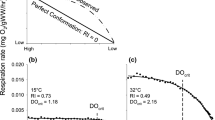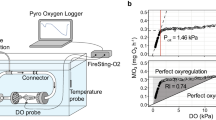Abstract
Estuarine environments are characterized by cyclical fluctuations in tides, with tidal shifts drastically, frequently, and acutely altering temperature, dissolved oxygen, and salinity. Despite these ecological challenges, the sheepshead minnow, Cyprinodon variegatus, seems to dominate estuarine landscapes. Here, we held sheepshead minnows to four temperature treatment groups for 1 month. We then tested whether temperature exposure had an effect on acute hypoxia tolerance via oxidative stress. We measured superoxide dismutase (SOD), catalase (CAT), and glutathione peroxidase (GPx) activities, as well as total antioxidant capacity and lipid peroxidation (LPO) damage in white muscle. We found that exposure to increasing temperatures (15, 20, 25, and 30 °C) for 1 month led to significantly higher CTmax in sheepshead minnows. We also found that CAT activity significantly increased in the 20 and 25 °C temperature treatment groups, whereas it did not change between control and hypoxia trials. SOD activity was significantly higher in control groups of the 15 and 30 °C temperature treatment groups compared with hypoxia groups of these same temperature treatments. GPx activity was significantly lower in the 30 °C temperature treatment group regardless of control or hypoxia trials. Hydroxyl scavenging capacity varied across temperature treatment and control/hypoxia groups. Peroxyl scavenging capacity and LPO damage showed no significant differences across temperature treatment groups or between control and hypoxia trials.



Similar content being viewed by others
Abbreviations
- ROS:
-
Reactive oxygen species
- SOD:
-
Superoxide dismutase
- CAT:
-
Catalase
- GPx:
-
Glutathione peroxidase
- LPO:
-
Lipid peroxidation
- CTmax :
-
Critical thermal maxima
- ASR:
-
Aquatic surface respiration
- LOE:
-
Loss of equilibrium
- MDA:
-
Malondialdehyde bis (dimethylacetal)
- GST:
-
Glutathione-s-transferase
References
Angilletta MJ (2009) Looking for answers to questions about heat stress: researchers are getting warmer. Funct Ecol 23(2):231–232
Ayala A, Muñoz MF, Argüelles S (2014) Lipid peroxidation: production, metabolism, and signaling mechanisms of malondialdehyde and 4-hydroxy-2-nonenal. Oxidative Med Cell Longev 2014:1–31
Becker CD, Genoway RG (1979) Evaluation of the critical thermal maximum for determining thermal tolerance of freshwater fish. Environ Biol Fish 4:245–256
Beitinger TL, Bennett WA, McCauley RW (2000) Temperature tolerances of North American freshwater fishes exposed to dynamic changes in temperature. Environ Biol Fish 58:237–275
Bennett WA, Beitinger TL (1995) Technical notes: overview of techniques for removing oxygen from water and a description of a new oxygen depletion system. Prog Fish Cult 57(1):84–87
Bennett WA, Bettinger TL (1997) Temperature tolerance of the sheepshead minnow, Cyprinodon variegatus. Copeia 1997(1):77–87
Bennett WA, Elkan A, Mayer FL, Beitinger TL (1995) Tolerance of the sheepshead minnow, (Cyprinodon variegatus), to selected environmental and chemical challenges (No. CONF-9511137--). Society of Environmental Toxicology and Chemistry, Pensacola
Birben E, Sahiner UM, Sackesen C, Erzurum S, Kalayci O (2012) Oxidative stress and antioxidant defense. World Allergy Organ J 5(1):9–19
Cao G, Prior RL (1999) [5] Measurement of oxygen radical absorbance capacity in biological samples. In: Lester P (ed) Methods in enzymology, vol 299. Academic Press, San Diego, pp 50–62
Catala A (2009) Lipid peroxidation of membrane phospholipids generates hydroxyl-alkenals and oxidized phospholipids active in physiological and/or pathological conditions. Chem Phys Lipids 157:1–11
Chandel NS, Budinger GS (2007) The cellular basis for diverse responses to oxygen. Free Radic Biol Med 42(2):165–174
Chown SL, Hoffmann AA, Kristensen TN, Angilletta MJ, Stenseth NC, Pertoldi C (2010) Adapting to climate change: a perspective from evolutionary physiology. Clim Res 43(1):3
Chung DJ, Bryant HJ, Schulte PM (2017) Thermal acclimation and subspecies- specific effects on heart and brain mitochondrial performance in a eurythermal teleost (Fundulus heteroclitus). J Exp Biol 220(8):1459–1471
Clotfelter ED, Lapidus SJH, Brown AC (2013) The effects of temperature and dissolved oxygen on antioxidant defences and oxidative damage in the fathead minnow Pimephales promelas. J Fish Biol 82(3):1086–1092
Cooper RU, Clough LM, Farwell MA, West TL (2002) Hypoxia-induced metabolic and antioxidant enzymatic activities in the estuarine fish Leiostomus xanthurus. J Exp Mar Biol Ecol 279(1–2):1–20
Cox DK (1974) Effects of three heating rates on the critical thermal maximum of bluegill. JW Gibbons, RR Sharitz (eds) National technical information service, CONF-730505, Springfield, Virginia. Thermal Ecology, pp 158–163
Dirmeier R, O'Brien KM, Engle M, Dodd A, Spears E, Poyton RO (2002) Exposure of yeast cells to anoxia induces transient oxidative stress implications for the induction of hypoxic genes. J Biol Chem 277(38):34773–34784
Dowling DK, Simmons LW (2009) Reactive oxygen species as universal constraints in life-history evolution. Proc R Soc B Biol Sci 276:1737–1745
Du SN, Mahalingam S, Borowiec BG, Scott GR (2016) Mitochondrial physiology and reactive oxygen species production are altered by hypoxia acclimation in killifish (Fundulus heteroclitus). J Exp Biol 219(8):1130–1138
Feder ME, Hofmann GE (1999) Heat-shock proteins, molecular chaperones, and the stress response: evolutionary and ecological physiology. Annu Rev Physiol 61(1):243–282
Freire CA, Welker AF, Storey JM, Storey KB, Hermes-Lima M (2011) Oxidative stress in estuarine and intertidal environments (temperate and tropical). Oxidative Stress in Aquatic Ecosystems:41–57
Gay CA, Gebicki JM (2003) Measurement of protein and lipid hydroperoxides in biological systems by the ferric-xylenol orange method. Anal Biochem 315:29–35
Grim JM, Simonik EA, Semones MC, Kuhn DE, Crockett EL (2013) The glutathione-dependent system of antioxidant defense is not modulated by temperature acclimation in muscle tissues from striped bass, Morone saxatilis. Comp Biochem Physiol A Mol Integr Physiol 164(2):383–390
Halliwell B, Chirico S (1993) Lipid peroxidation: its mechanism, measurement, and significance. Am J Clin Nutr 57:715S–725S
Helmuth B, Kingsolver JG, Carrington E (2005) Biophysics, physiological ecology, and climate change: does mechanism matter? Annu Rev Physiol 67:177–201
Hermes-Lima M, Storey KB (1993) Role of antioxidants in the tolerance of freezing and anoxia by garter snakes. Am J Phys 265:R646–R652
Hermes-Lima M, Storey KB (1996) Relationship between anoxia exposure and antioxidant status of the frog Rana pipiens. Am J Phys 271:R918–R925
Hermes-Lima M, Willmore WG, Storey KB (1995) Quantification of lipid peroxidation in tissue extracts based on Fe(III)xylenol orange complex formation. Free Radic Biol Med 19:271–280
Hernansanz-Agustín P, Izquierdo-Álvarez A, Sánchez-Gómez FJ, Ramos E, Villa- Piña T, Lamas S, Bogdanova A, Martínez-Ruiz A (2014) Acute hypoxia produces a superoxide burst in cells. Free Radic Biol Med 71:146–156
Hochachka PW, Buck LT, Doll CJ, Land SC (1996) Unifying theory of hypoxia tolerance: molecular/metabolic defense and rescue mechanisms for surviving oxygen lack. Proc Natl Acad Sci 93(18):9493–9498
Issartel J, Hervant F, De Fraipont M, Clobert J, Voituron Y (2009) High anoxia tolerance in the subterranean salamander Proteus anguinus without oxidative stress nor activation of antioxidant defenses during reoxygenation. J Comp Physiol B 179(4):543–551
Jentsch A, Kreyling J, Beierkuhnlein C (2007) A new generation of climate-change experiments: events, not trends. Front Ecol Environ 5:365–374
Jiang B, Ren C, Li Y, Lu Y, Li W, Wu Y, Gao Y, Ratcliffe PJ, Liu H, Zhang C (2011) Sodium sulfite is a potential hypoxia inducer that mimics hypoxic stress in Caenorhabditis elegans. J Biol Inorg Chem 16(2):267–274
Johnson JG, Paul MR, Kniffin CD, Anderson PE, Burnett LE, Burnett KG (2015) High CO2 alters the hypoxia response of the Pacific whiteleg shrimp (Litopenaeus vannamei) transcriptome including known and novel hemocyanin isoforms. Physiol Genomics 47(11):548–558
Kearney M, Porter W (2009) Mechanistic niche modelling: combining physiological and spatial data to predict species’ ranges. Ecol Lett 12(4):334–350
Kramer DL, McClure M (1982) Aquatic surface respiration, a widespread adaptation to hypoxia in tropical freshwater fishes. Environ Biol Fish 7(1):47–55
Logan CA, Somero GN (2010) Transcriptional responses to thermal acclimation in the eurythermal fish Gillichthys mirabilis (Cooper 1864). Am J Physiol Regul Intgr Comp Physiol 299(3):R843–R852
Lushchak VI (2011) Environmentally induced oxidative stress in aquatic animals. Aquat Toxicol 101(1):13–30
Lushchak VI, Bagnyukova TV (2006a) Effects of different environmental oxygen levels on free radical processes in fish. Comp Biochem Physiol B Biochem Mol Biol 144(3):283–289
Lushchak VI, Bagnyukova TV (2006b) Temperature increase results in oxidative stress in goldfish tissues. 2. Antioxidant and associated enzymes. Comp Biochem Physiol C Toxicol Pharm 143(1):36–41
Lushchak VI, Bagnyukova TV (2006c) Temperature increase results in oxidative stress in goldfish tissues. 1. Indices of oxidative stress. Comp Biochem Physiol C Toxicol Pharm 143(1):30–35
Lushchak VI, Bagnyukova TV (2007) Hypoxia induces oxidative stress in tissues of a goby, the rotan Perccottus glenii. Comp Biochem Physiol B Biochem Mol Biol 148(4):390–397
Lushchak VI, Lushchak LP, Mota AA, Hermes-Lima M (2001) Oxidative stress and antioxidant defenses in goldfish Carassius auratus during anoxia and reoxygenation. Am J Physiol Regul Intgr Comp Physiol 280(1):R100–R107
Lushchak VI, Bagnyukova TV, Lushchak V, Storey JM, Storey KB (2005) Hypoxia and recovery perturb free radical processes and antioxidant potential in common carp (Cyprinus carpio) tissues. Int J Biochem Cell Biol 37(6):1319–1330
Madeira D, Narciso L, Cabral HN, Vinagre C, Diniz MS (2013) Influence of temperature in thermal and oxidative stress responses in estuarine fish. Comp Biochem Physiol A Mol Intgr Physiol 166(2):237–243
Madeira D, Vinagre C, Diniz MS (2016) Are fish in hot water? Effects of warming on oxidative stress metabolism in the commercial species Sparus aurata. Ecol Indic 63:324–331
Malek RL, Sajadi H, Abraham J, Grundy MA, Gerhard GS (2004) The effects of temperature reduction on gene expression and oxidative stress in skeletal muscle from adult zebrafish. Comp Biochem Physiol C Toxicol Pharm 138(3):363–373
Monaghan P, Metcalfe NB, Torres R (2009) Oxidative stress as a mediator of life history trade-offs: mechanisms, measurements and interpretation. Ecol Lett 12:75–92
Nordlie FG (2006) Physicochemical environments and tolerances of cyprinodontoid fishes found in estuaries and salt marshes of eastern North America. Rev Fish Biol Fish 16(1):51–106
Peterson MS (1990) Hypoxia-induced physiological changes in two mangrove swamp fishes: sheepshead minnow, Cyprinodon variegatuslacepede and sailfin molly, Poecilia latipinna (lesueur). Comp Biochem Physiol A Physiol 97(1):17–21
Prior RL, Cao G (1999) In vivo total antioxidant capacity: comparison of different analytical methods. Free Radic Biol Med 27:1173–1181
Somero GN, Lockwood BL, Tomanek L (2017) Biochemical adaptation: response to environmental challenges, from life's origins to the Anthropocene. Sinauer Associates, Incorporated Publishers, Sunderland
Sørensen JG, Kristensen TN, Loeschcke V (2003) The evolutionary and ecological role of heat shock proteins. Ecol Lett 6(11):1025–1037
Storey KB (1996) Oxidative stress: animal adaptations in nature. Braz J Med Biol Res 29:1715–1733
Subrahmanyam CB (1980) Oxygen consumption of estuarine fish in relation to external oxygen tension. Comp Biochem Physiol A Physiol 67(1):129–133
Tripathi RK, Mohindra V, Singh A, Kumar R, Mishra RM, Jena JK (2013) Physiological responses to acute experimental hypoxia in the air-breathing Indian catfish, Clarias batrachus (Linnaeus, 1758). J Biosci 38(2):373–383
Tuller ER, Beavers CT, Lou JR, Ihnat MA, Benbrook DM, Ding WQ (2009). Docosahexaenoic acid inhibits superoxide dismutase 1 gene transcription in human cancer cells: the involvement of peroxisome proliferator-activated receptor α and hypoxia-inducible factor-2α signaling. Mol Pharmacol 76(3):588–595
Vig E, Nemcsok J (1989) The effect of hypoxia and paraquat on the superoxide dismutase activity in different organs of carp, Cyprinus carpio L. J Fish Biol 35:23–25
Vinagre C, Madeira D, Narciso L, Cabral HN, Diniz M (2012) Effect of temperature on oxidative stress in fish: lipid peroxidation and catalase activity in the muscle of juvenile seabass, Dicentrarchus labrax. Ecol Indic 23:274–279
Welker AF, Moreira DC, Campos EG, Hermes-Lima M (2013) Role of redox metabolism for adaptation of aquatic animals to drastic changes in oxygen availability. Comp Biochem Physiol A Mol Integr Physiol 165:384–404
Wolff SP (1994) Ferrous ion oxidation in presence of ferric ion indicator xylenol orange for measurement of hydroperoxides. In: Lester P (ed) Methods in enzymology, vol 233. Academic Press, London, pp 182–189
Wong GT, Zhang LS (1992) Chemical removal of oxygen with sulfite for the polarographic or voltammetric determination of iodate or iodide in seawater. Mar Chem 38(1–2):109–116
Acknowledgments
We are grateful to Ms. MaryKathryn McCann for her assistance in integrating and analyzing ORAC data.
Funding
Funding for this project was provided by Colgate University.
Author information
Authors and Affiliations
Corresponding author
Rights and permissions
About this article
Cite this article
Jimenez, A.G., Braun, E. & Tobin, K. How does chronic temperature exposure affect hypoxia tolerance in sheepshead minnows’ (Cyprinodon variegatus variegatus) ability to tolerate oxidative stress?. Fish Physiol Biochem 45, 499–510 (2019). https://doi.org/10.1007/s10695-018-0583-0
Received:
Accepted:
Published:
Issue Date:
DOI: https://doi.org/10.1007/s10695-018-0583-0




